Apple's 2010 MacBook Air (11 & 13 inch) Thoroughly Reviewed
by Anand Lal Shimpi on October 26, 2010 10:08 PM EST- Posted in
- Mac
- Apple
- MacBook Air
- Laptops
The SSD: Not Half Bad
Apple advertises the new MacBook Air as being instant on as a result of the internal SSD. That’s mostly untrue. From a completely powered off state the MacBook Air still takes time to boot. That time is significantly reduced compared to the old MacBook Air and any other Mac with a conventional hard drive. It’s even a shorter boot than my MacBook Pro with a SandForce SF-1200 based SSD in it:
| System Performance Comparison | ||||||
| Boot | Shut Down | Sleep | Awake | |||
| 11-inch MacBook Air | 15.5 seconds | 2.2 seconds | 1.0 second | 1.63 seconds | ||
| 13-inch MacBook Air | 14.4 seconds | 1.9 seconds | 1.0 second | 1.56 seconds | ||
| 13-inch MacBook Air (Late 2008) | 34.4 seconds | 2.9 seconds | 1.6 seconds | 4.19 seconds | ||
| 15-inch MacBook Pro (SF-1200 SSD) | 19.1 seconds | 1.8 seconds | 1.5 seconds | 2.3 seconds | ||
| 15-inch MacBook Pro (Mid 2009, HDD) | 34.2 seconds | 2.8 seconds | 1.8 seconds | 2.1 seconds | ||
You'll notice that even the SF-1200 SSD in my 15-inch MacBook Pro takes longer to boot than these new Airs. Apple does customize the firmware on its SSDs. I’d be willing to bet the SSD in the MacBook Air has tight integration with OS X to guarantee quicker than normal boot times.
Clearly the new Air isn't instant on from a boot standpoint, but it's pretty much there from a recover-from-sleep standpoint. The new Airs both go to sleep and wake up from sleep quicker than any of the other Macs, including my upgraded 15-inch Core i7 MacBook Pro. Again, nothing can trump Apple's tight integration between hardware and software.
Apple likes to work with two different controller manufacturers for SSDs: Samsung and Toshiba. iFixit already confirmed Toshiba is in the new MacBook Air with its teardown:
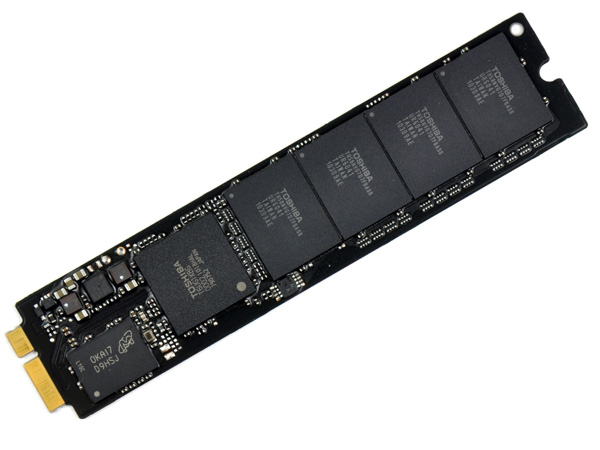
The 11-inch MacBook Air SSD, courtesy of iFixit
The SSD isn’t in an industry standard form factor, although the connector appears to be either micro or mini SATA. Presumably 3rd party SSD manufacturers (ahem, SandForce partners I’m looking at you) could produce drop in replacements for the MacBook Air SSD.
There’s nothing particularly innovative about the form factor of the SSD, other than Apple did away with the unnecessary space a 2.5” SSD would require. Just as SSDs will break the traditional SATA interface barriers, we’ll see the same happen to form factors as well.
The part number on the Toshiba controller may look familiar to some of you. It’s the same controller that’s in Kingston’s SSDNow V+ Series and the SSDNow V Series Boot Drive. I reviewed the latter not too long ago and found that it was a good drive for the money, and here’s the kicker: the SSDNow V Series Boot Drive was amazingly resilient when written to without TRIM support. Its performance hardly dropped as a result of normal desktop use. This is very important because although OS X 10.6.4 has a field for reporting TRIM support on an SSD, the instruction isn’t actually supported by the OS. Even the new MacBook Airs don’t ship with a version of OS X with TRIM support.
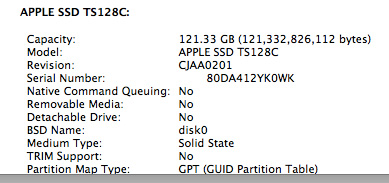
The SSD only has four NAND devices on it. Typically that would mean some very low transfer speeds, particularly on writes. But each one of those four devices has at least 16GB of NAND, spread across multiple planes and die. With the right firmware, you should be able to extract a good deal of parallelism from this architecture. Apple and Toshiba apparently do just that.

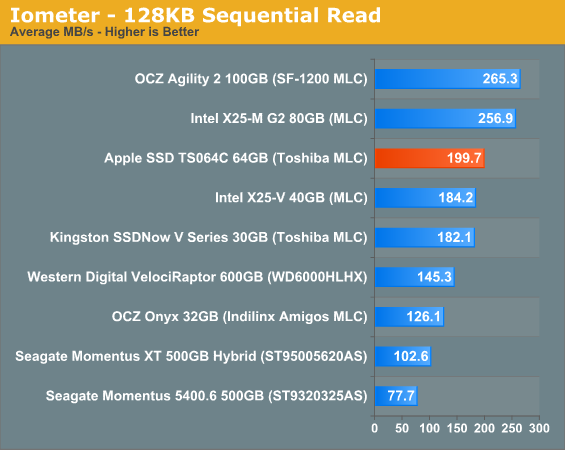
While most value SSDs top out at under 100MB/s, we get nearly 200MB/s sequential reads and writes out of the SSD in the new MacBook Air. And fortunately, Apple hasn’t only focused on sequential performance. The random read/write performance of the new MacBook Air SSD isn’t terrible:
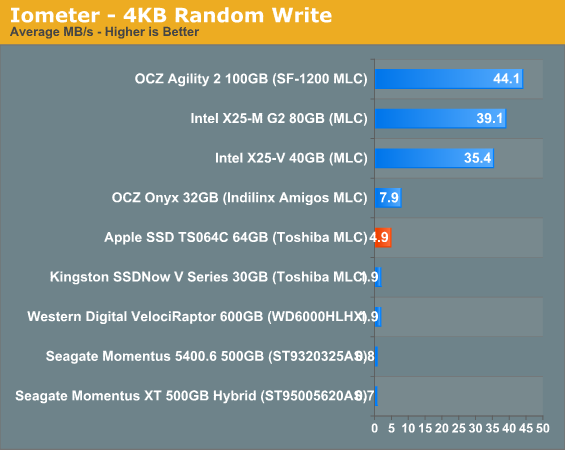
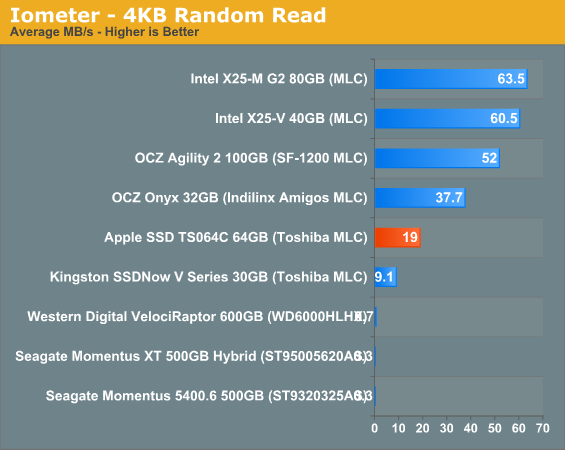
Random write performance is of course the weak point, but you’ll notice that it’s actually higher than the Kingston drive that uses the same controller. While Apple would’ve been better off striking a deal with Intel or SandForce for the controller in the MacBook Air, the Toshiba controller isn’t horrible.
As I mentioned earlier, resilience is very important as OS X still doesn’t support TRIM. I filled the drive with garbage and then tortured it for 20 minutes with random writes. The resulting performance drop was noticeable, but not unbearable:
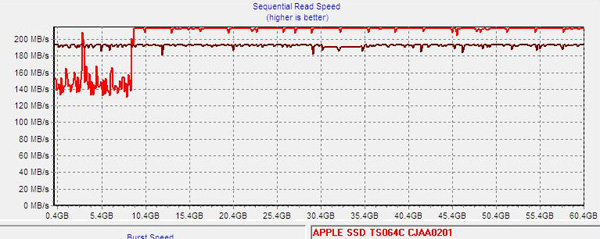
A single pass of sequential writes restores performance to normal:
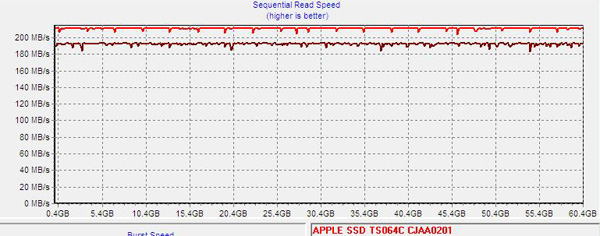
This tells us two things. First, through normal use the drive should be able to recover its performance over time (assuming you give it enough spare area). And second, if there’s any idle garbage collection in Apple’s custom firmware for the Toshiba controller it should be able to keep the drive running at peak performance even without TRIM supported in the OS. I don’t have a good way of measuring whether or not there’s GC enabled on the drive in OS X, but I suspect Apple is (at least it appears to be doing so on the Mac Pro’s SSDs).
Overall I’m pleased with Apple’s SSD selection. It could’ve been a lot better but it could’ve been a lot worse. The MacBook Airs in their default configuration have better IO performance than any other standard config Mac sold on the market today, including the Mac Pro.










185 Comments
View All Comments
Sabresiberian - Wednesday, October 27, 2010 - link
When someone resorts to name-calling they lose respect from me. Putting down people with a medical or educational diagnosis in the process causes me to think even less of them.Put a reasonable argument out there, back it up with some numbers, then let it go if the other party doesn't get it; it's all you can do. If you resort to name-calling that is about you, not him (or her) and your state of mind. If you feel tempted to bash someone by calling them " [expletives deleted]" then take a moment - go punch a pillow and scream at it or whatever you need to - and get clear before you post.
If your intent is to just make people mad and isn't to actually have a discussion - well, there's nothing I can say about that except, have a nice life, and enjoy your stiff neck, back aches, and ulcers.
;)
huai - Monday, November 1, 2010 - link
MBA currently has space on its board for 2 chips:C2D CPU
Nvidia Chipset w/ integrated GPU and USB2.0 controllers
You propose a 5 chip solution:
Core i CPU
Intel Chipset (which doesn't support USB3.0)
3rd party USB 3.0 controller
Dedicated GPU
Optimus
Where's the space going to come for this? Are you willing to cut battery life by a third to make room?
freefallgrue - Thursday, November 4, 2010 - link
No FireWire? Get real.michael2k - Wednesday, October 27, 2010 - link
No, the MacBook 13 needs to become cheaper. If the "elite" MBA11 is $999, the MB13 should be $899.Four screen sizes is a non issue, any more than it is for Dell, Lenovo, or HP.
1) 11.6" is great as an entry point as it allows for a full sized keyboard
2) 13.3" is great as a portable as it allows for speakers and a full sized keyboard
3) 15" allows for greater performance without loss in portability
4) 17" maximizes performance for a tradeoff in portability
The pro terminology is perfect as it indicates more performance. The problem is that the 13" MBP shouldn't be a Pro since it lacks a Core i3; if we get rid of any, it should be the 13" MBP.
If you want a logical and maximal pricing structure:
MB 11: $899
MBA 11: $999
MB 13: $999 (no optical but only 4 pounds)
MBA 13: $1299
MBP 13: $1299 (no optical but core i3)
MBP 15: $1599
MBP 17: $1799
martyrant - Tuesday, October 26, 2010 - link
Macs make fancy looking products, but as you notice you compare apples to apples because at a lower price range these products would be getting smashed against $1000 price-point laptop PCs.I just don't get the appeal for paying for less, but I do know there's a lot of less-than-brilliant people out there that can't tell when they are being owned by advertising and no matter what anyone does there's always going to be those less-than-brilliant (yes, that's sarcasm) roaming the planet, so by all means dump your money into a cult like company.
I just find it funny that Anandtech got all Apple over the past 3-4 years, I don't remember seeing that many Mac reviews prior to that. You getting a kick back now?
hmurchison - Tuesday, October 26, 2010 - link
Yes but the problem is we Mac users don't want to run Windows or Linux for the sake of hardware that looks better on paper. As Anand said in his review...the tight integration of the OS and the hardware means that Apple extracts more performance out their computers than what is typical of the industry.It's not about Advertising it's about design and aesthetics that extend from the hardware to the software. To some it's appealing much as a BMW is more appealing than say a Ford to car lovers.
With 50 million Mac users and 3-4x times that amount of iPod/iphone/iPad users Apple left Cult status a LONG time ago. $300 a share isn't a cult ..that's good biz.
martyrant - Tuesday, October 26, 2010 - link
Have you heard Steve Jobs talk? That's cult like.And everything you just said proves my point, you got owned by advertising (design and aesthetics? lol, c'mon).
You are on a IT site, with most of us probably knowing how to dremel, cut, and completely customize our cases, hardware, and software (yeah, we can program too!)
Macs are for people who can't customize their own computers (both design, aesthetically, and software) themselves and like to pay out the bum to feel part of the cult.
AMDJunkie - Tuesday, October 26, 2010 - link
"You are on a IT site, with most of us probably knowing how to dremel, cut, and completely customize our cases, hardware, and software (yeah, we can program too!)"Very good. Make a laptop from the ground up with the exact same dimensions, fit, finish, as the MacBook Air; while also surpassing it in benchmark prowess, appearance of speed, and battery life. And since you can program too, might as well make your own OS while you're at it. I suppose you could appropriate another and make your own modifications to it, as long as it works as well as what Apple has.
Go on...
Riiiiight. Just because they're designed to appeal to aesthetes does not mean there is not quite a bit of engineering that goes into these. When you go through the iFixIt, or take it apart for yourself and reassemble it, you'll have a greater appreciation for Apple's "toys."
Also, keep on trollin'.
sprockkets - Tuesday, October 26, 2010 - link
Tell me what the value is on a $1000 plastic Macbook with an outdated processor, ram capacity and everything else.Sorry, OSX isn't worth the extra $500 premium.
martyrant - Wednesday, October 27, 2010 - link
Point is, if I wanted to, it could be done. Why would I have to write my own OS when it's possible to modify and customize one of the better ones out there? (If you noticed, I haven't bashed OS X at all, simply their price point on their hardware).Mac users are just used to paying more for less, which is the point in all my trolling points.
Sounds like a bunch of idiots to me.